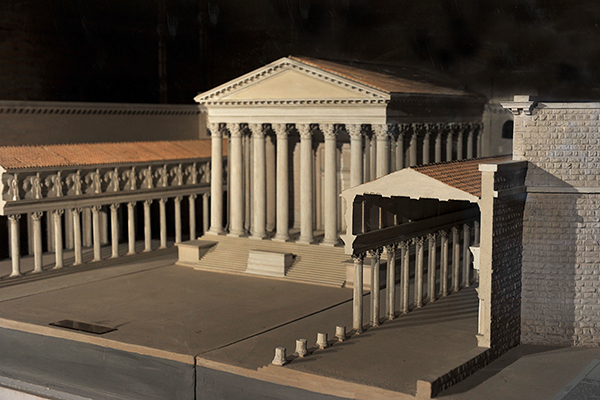

"Next to the immortal Gods he honoured the memory of the leaders who had raised the estate of the Roman people from obscurity to greatness. Accordingly he restored the works of such men with their original inscriptions, and in the two colonnades of his forum dedicated statues of all of them in triumphal garb, declaring besides in a proclamation: 'I have contrived this to lead the citizens to require me, while I live, and the rulers of later times as well, to attain the standard set by those worthies of old.'"
Suetonius, Augustus (XXXI.5)
Elevated three steps above a white travertine courtyard, twin porticos ran the length of the Forum, flanking the Temple of Mars Ultor. Columns of yellow giallo antico marble supported a coffered entablature surmounted by an attic in white marble decorated with caryatids. Along the back wall from these colonnades and enclosed by hemicycles were a series of niches framed by engaged columns that held, on the western side, statues of the Julian clan and the kings of Alba Longa (where Romulus and Remus had been born) and, on the other, the summi viri of Rome, each with a prominent inscription (elogia) recording his offices (cursus honorum) and accomplishments.
Given the irregular dimensions of the precinct wall, there was room at the end of the western portico for a separate hall, which contained a monumental statue of Augustus (Martial, Epigrams, VIII.44), possibly placed there by Claudius or Tiberius, the imprint of the left foot still visible. It may have been here, too, that paintings by Apelles of Alexander the Great in War and Victory were to be seen (Pliny, XXXV.x.27; Servius, Commentary on the Aeneid, I.294). This association with the emperor was made even more deliberate by Claudius, who later substituted the face of Alexander in both pictures with that of Augustus (Pliny, XXXV.xxxvi.94). Pliny also records that two of the four statues said to have supported Alexander's tent were placed before the Temple of Mars (the other two set up in the Regia (XXXIV.xviii.48).
It is not possible to know with certainty how the statues of these great men were arrayed around the exedrae and porticoes. Suetonius implies that they were placed in both porticoes of the Forum, Dio that "such victors and all others who receive triumphal honours should have their statues in bronze erected in the Forum" (Roman History, LV.10.3), and the Scriptores Historiae Augustae that Augustus "erected in his forum marble statues of the most illustrious men, together with the record of their achievements" (XXVIII.6). The names of Spain and other Roman provinces also were displayed (Velleius Paterculus, Roman History, II.39.2).
The wood and plaster model of the Forum of Augustus is in The Museum of the Imperial Forums in Trajan's Market (Rome). Constructed in 1937 by Italo Gismondi, who also built the Model of Rome, it is 1:50 scale.
References: Suetonius: The Lives of the Caesars (1914) translated by J. C. Rolfe (Loeb Classical Library); Scriptores Historiae Augustae (1924) translated by David Magie (Loeb Classical Library); Velleius Paterculus: Compendium of Roman History (1924) translated by Frederick W. Shipley (Loeb Classical Library); Dio Cassius: Roman History (1914-) translated by Earnest Cary and Herbert B. Foster (Loeb Classical Library).
![]()